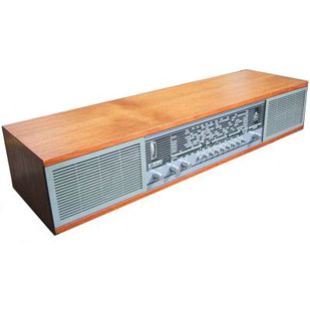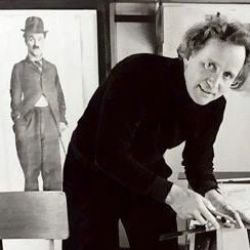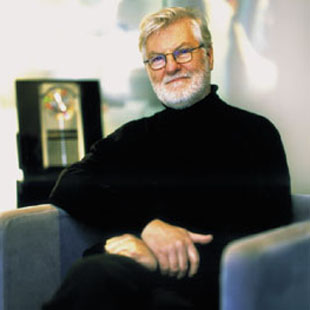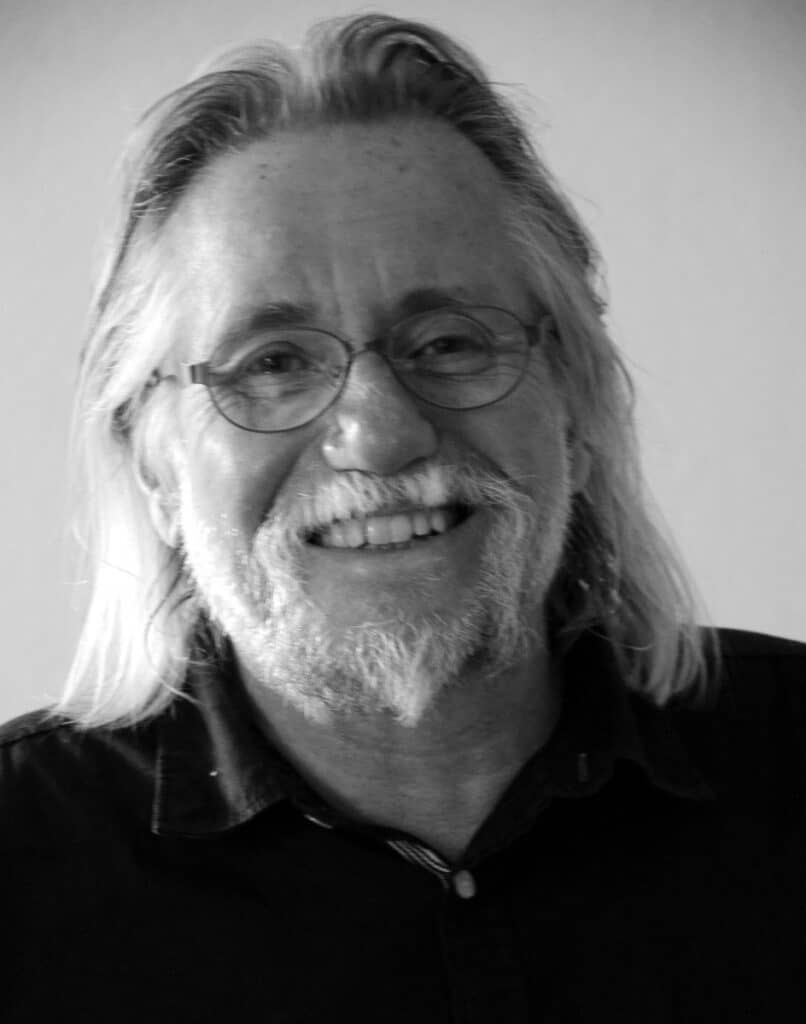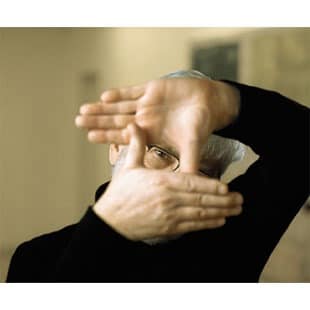Jacob Jensen is a product designer with the greatest number of honours and awards in the world. His works are timeless and many of them are on permanent show in museums across the globe. Born in 1926 in the Copenhagen suburb of Vesterbro his career started first as a slaughterhouse apprentice and then an apprentice upholsterer in 1942 at the age of 16.
Working later in his father’s small furniture shop he began his design career by designing beds, chairs and other furniture. One of the chairs designed by him was awarded a prize and encouraged by this achievement and his father, he applied for admission to Denmark’s School of Arts, Crafts in Design. He successful achieved his ambition and was accepted three years later. This was supplemented with an early association with Bernadotte & Bjørn’s drawing office (1954 – 1959), the first industrial design drawing office in Denmark.
He became assistant professor of industrial design at Chicago University (1959-61), partner in the ID firm Latham, Tyler & Jensen, New York/Chicago (1959-61) and set up his own company in Denmark in 1958. Jacob Jensen’s ability to work with shape was quickly combined with his skill at finding solutions to problems of a technical nature.
In 1962 he set up his own drawing office on a hillside sloping down to the Limfjord in North Jutland. It is from here he derives inspiration for his severe, horizontal, minimalist idiom, in which the characteristic qualities of Danish neo-classicism can be discerned in shape and colour. This applies especially to his many works for the electronics firm of Bang & Olufsen, the success of which is to a great extent dependent on the design types developed by Jacob Jensen in the 1960s.
He has created more than 500 industrial products for Danish and foreign companies. His best known works include product design for Bang & Olufsen A/S, among others Beolit 600 (1970), Beogram 4000 (1972) and Beocenter 9000 (1986), an astronomical clock for Max René, office chairs for Labofa A/S, Comet telephone for Standard Electric Kirk (today Kirk Telecom A/S) (1976), toys for LEGO, kitchen appliances for Gaggenau Hausgeräte GmbH, watches, telephone and the Jensen-One cars for Max Rene Ltd and loudspeakers for Dantax A/S.
Awards include the IDSA Award (1978), the Thorvald Bindesbøll Medal (1983), International Design Award, Osaka (1985), Good design, Osaka (1986 and 1989) and the ID Classics Prize (1990). He published his memoirs ‘Anderledes, men ikke mærkeligt’ (‘Different, but not strange’) in 1997.
Jacob Jensen’s association with Bang & Olufsen
Jacob Jensen Design received particular recognition in connection with Bang & Olufsen where Jacob Jensen was chief designer for more than two decades during which time he created an extensive line of audio products in a form language which was innovative and recognised on an international scale.
FACT – Did you know the first piece of work Jensen did for B&O was the Beomaster 1000 version 2? He just changed the colour of the top panel from white to black!
The working relationship between B&O and Jacob Jensen began in 1965 and went on in various forms until 1991. During the years 1965 – 1985 the designer developed the exclusive and aesthetic form language which today, continues to be the basis of B&O’s conceptual and visual platform.
From 1985 to 1989 Jacob Jensen functioned as adviser to B&O on matters of design and strategy. Altogether, Jacob Jensen has designed more than one hundred products for the hi-fi and video company, among them music systems, amplifiers, record players, tape recorders, CD-players, remote controls and loudspeakers. Around 1500 design models were conceptualised.
The majority of these products have been awarded design prizes both nationally and internationally as well as being included in museum collections all over the world.
Design for sound by Jacob Jensen Exhibition (1978)
Many of Jacob Jensen’s design for Bang & Olufsen are included in the Design Collection of the Museum of Modern Art (MoMA) in New York. As one of the few industrial designers in the world, Jacob Jensen was chosen in 1978 by MoMA for a solo exhibition: ‘Design for Sound by Jacob Jensen’. The exhibition included 28 audio products. The exhibition was an exceptional gesture of recognition both for B&O and Jacob Jensen for at that time, the museum had only twice before arranged solo exhibitions of single companies’ products (an Olivetti exhibition in the thirties and a Braun exhibition in the sixties)
His relationship with B&O resulted in a classic form language and a series of products, which alone – as the New York Times concluded in its review of the exhibition at MoMA “are enough to earn him major rank among the 20th century’s industrial designers”.
1978 – a busy year in anyone’s language!
Two of Bang & Olufsen’s passive loudspeakers – Beovox C40 and C75 – designed by Jacob Jensen, were awarded with the Danish ID prize in 1978. Other notable events that year included:
Beogram 4002 was included in the Design Collection at MoMA
B&O received the Excellence prize by the IDSA, USA
B&O exhibition at Jerusalem Museum
New York’s MoMA also chose seven Bang & Olufsen products, designed by Jacob Jensen to be included in their permanent Design Collection as being striking examples of the museum’s criteria for quality and historical importance; designs in fact, which had influenced the twentieth century.
Those products were:
Beogram 1200 turntable
Beovox 2700 loudspeakers
Beomaster 1200 radio / amplifier
Beomaster 3000-2 radio / amplifier
Beovox 3700 loudspeakers
Beolit 400 transistor radio
Beolit 1000 transistor radio
From 1972 through 1991 MoMA has further included 19 of Jacob Jensen’s designs in their Design Collection and Design Study Collection.
Steeling wood
Stainless steel and shiny aluminium products are all well and good, but they are just so … clinical. I’m not sure whether people actually live in those sorts of houses. We all pick up magazines and these are the messages that we’re supposed to aspire to… cold, hard-surfaced rooms devoid of anything that is in ay way personal to us. It makes for cleaning the rooms very easily but the whole aspect of living like this is so unreal.
What appealed to me about Jacob Jensen’s products was that you just wanted to reach out and touch them. You can’t do this with modern hi-fi and video products that Bang & Olufsen is creating… it’s as though they’re objects in an art gallery and you’re almost frightened that if you do happen to get your greasy fingermarks on them, a whole army of Mr Mops and security guards would rush out screaming “Don’t touch! Eyes only!”
Jensen’s products were the antipathy of this – they reached out to you shouting “rub your eyes, fingers and any other part of your anatomy on me. I’m not here just to look good and sound good but to let you stroke and caress me too”.
The warmth of his natural wood veneers warmed the coldest of interior décors… you didn’t need the heating turned up to feel the glow that emanated from them. It was the best of both world really, with sheets of brushed aluminium contrasting gracefully and stylishly against the natural wood; the choice of colour was often yours, from blond oak to rich rosewood which complemented any domestic setting. It’s quite amazing that wood-framed hi-fi and television sets just haven’t gone away. Walk into any Comet or Darty and you can see Far Eastern manufacturers brashly copying the products of the past While B&O still feel a certain amount of smugness in believing they lead the 21st century way, the public speak with their portefeuilles and cashiers’ tills ring with the sale of look-good and feel-good wood products.
Wood will come and go like the tide… once out, the wind of change will blow it back in again.
Below is an interview which Mr Jacob Jensen very kindly undertook especially for BeoWorld and appeared in the Newsletter of early December 2005:
BeoWorld is proud to be able to be associated with Jacob-Jensen Design of Denmark. As a mark of this new cooperation, BeoWorld has been given an exclusive interview with Jacob Jensen, long-time designer of many Bang & Olufsen products such as the Beomaster 1900, the Beovox 2500 Cube speakers and Beosystem 5000.
We are sure that Mr Jensen’s words will be of great interest to collectors of Bang & Olufsen and thank him for his time. We would also like to wish both Jacob and his new wife happiness in their marriage and success in the future!
How did your relationship begin with B&O?
B&O contacted me because I had done a line of audio for General Electric in 1960 and a receiver for the Danish Company TO-R with a design language, which was unique and appealing to B&O.
Which Bang & Olufsen design are you most proud of?
The products, which I did in the seventies were completely different and had a high aesthetic quality. A good example is Beogram 4000 and the Beomaster 1900 line, but also the Beocenter 9000, which I did together with my son Timothy Jacob Jensen, is in many people’s opinion a masterpiece.
Which was the most difficult product to produce, technically and design-wise?
Due to the fact that the products made in the seventies were completely new with a compact height, they were all difficult to construct. For the Beogram 4000 and other products, I had a close relationship with an engineer called K.G. Zeuten, who by the way also constructed aeroplanes. Some of these products were constructed and designed outside B&O. It was necessary because B&O was not able to make it themselves.
Do you own and use Bang & Olufsen products now?
I own and use B&O products at home, and my favourites are the products made in the seventies and eighties.
Which pieces of your work would you most like to see displayed in the BeoWorld Museum?
I would like to see the Beovox Cube, Beogram 4000, Beomaster 1900, Beocenter 9000 and B&O IR remote control wristwatch.
What do you think of the present Bang & Olufsen range?
The present B&O range has a clear connection to the design language and product philosophy I started in the sixties, and I am happy and proud that my former employee, David Lewis has achieved to continue my form language. I believe that this will also be the communication platform for B&O in the future.
Which product designer do you most admire?
In Denmark we had a pioneer designer, Kare Klint, who started the difficult process of combining use and aesthetics for household products. I have always felt a close relationship to him. His philosophy was: Form follows function, compared to ours, which is more: Form follows feelings.
Do you see any future cooperation with B&O?
I would like to make the next breakthrough at B&O, but my experience tells me that it takes years and a lot of power to do, therefore it is up to the next generation.
What are you doing now that you have retired?
I think that creative people will never retire, so therefore I am still doing some designs for JJD Studio, which my son, Timothy Jacob Jensen is successfully running. Beside that, I am painting, writing, playing instruments and having a wonderful time with my young and beautiful wife, whom I married five months ago.
His favourite product was the Beogram 4000.

